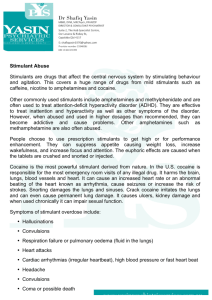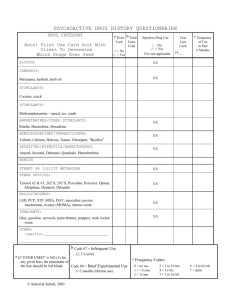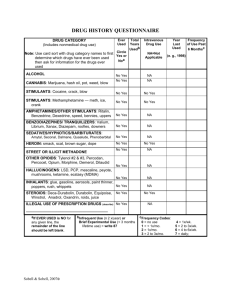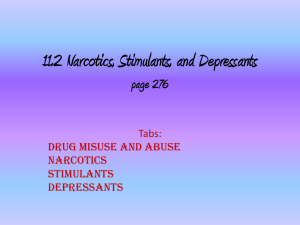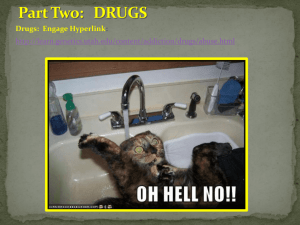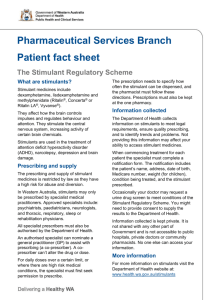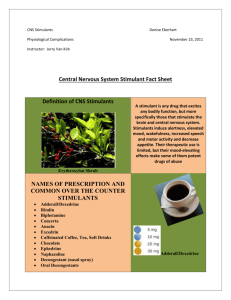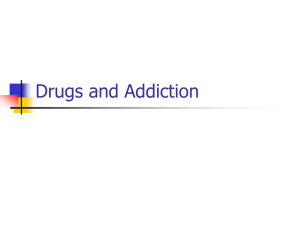Fact Sheet on CNS Stimulants
advertisement
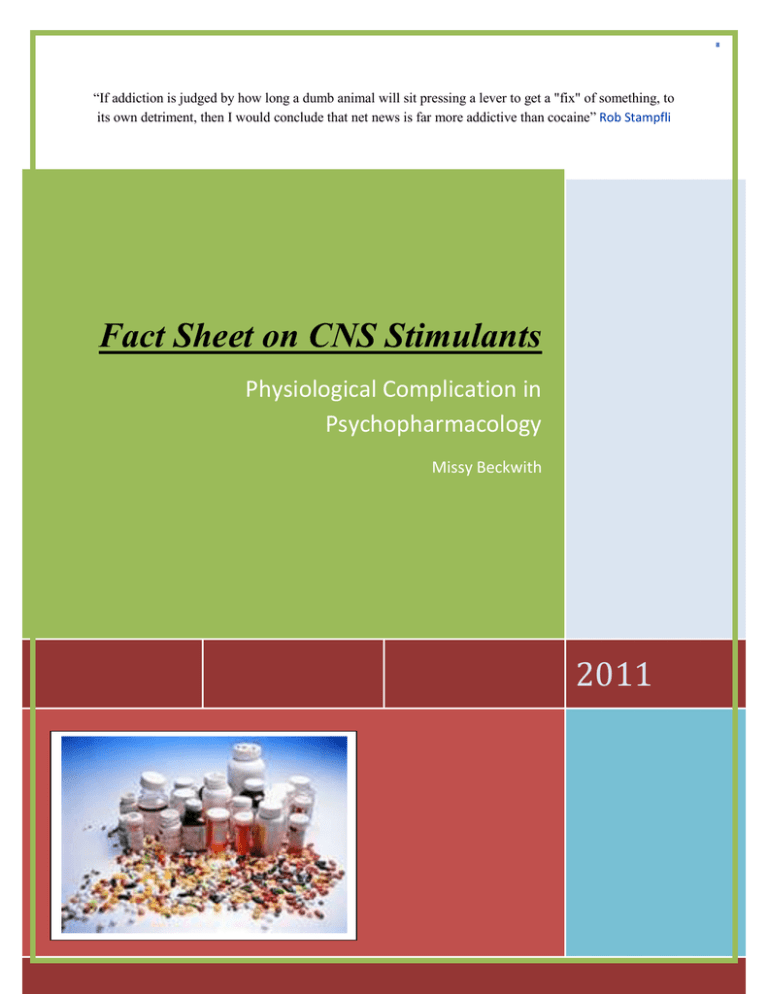
“If addiction is judged by how long a dumb animal will sit pressing a lever to get a "fix" of something, to its own detriment, then I would conclude that net news is far more addictive than cocaine” Rob Stampfli Fact Sheet on CNS Stimulants Physiological Complication in Psychopharmacology Missy Beckwith 2011 Fact Sheet on CNS Stimulants. What are Central Nervous System (CNS) Stimulants ? Central nervous system (CNS) stimulants are medicines that speed up physical and mental processes. (1) This includes the two most frequently-used drugs on the planet, caffeine and nicotine. (2) Amphetamines, methamphetamine, cocaine and methylphenidate (Ritalin) are all stimulants. (6) As the name suggests, stimulants increase alertness, attention, and energy, as well as elevate blood pressure, heart rate, and respiration. Stimulants historically were used to treat asthma and other respiratory problems, obesity, neurological disorders, and a variety of other ailments. But as their potential for abuse and addiction became apparent, the medical use of stimulants began to wane. Now, stimulants are prescribed to treat only a few health conditions, including ADHD, narcolepsy, and occasionally depression—in those who have not responded to other treatments. (3) All stimulant drugs cause an increase in general behavioral activity. When taken short-term (one or two weeks), stimulant drugs cause states of euphoria, optimism, and general feelings of wellbeing. Initial feelings of anorexia are frequent, a quality that leads to their use/abuse in weight loss products. Insomnia is also frequent. These responses indicate that the part of the brain which controls these functions, the hypothalamus, is strongly affected by these drugs and that the dopamine transmitter system is primarily involved in many of these effects. Other effects are: decreased feelings of depression increased thoughts and associations increased talkativeness increased blood pressure anxiety irritability decreased fatigue (2) What are names of prescription, OTC, common and illicit CNS Stimulants? Examples include cocaine, methamphetamine, amphetamines, methylphenidate (Ritalin), nicotine, caffeine, and MDMA (3,4-methylenedioxymethamphetamine), better known as “Ecstasy” (12) caffeine, nicotine, over the counter cold medicines, chocolate, diet pills, like ephedrine, or ma huang, and the class of drugs known as amphetamines- both legally prescribed and illegal. (18) Cocaine comes in two forms. Powder cocaine is a hydrochloride salt, made from the leaf of the coca plant. “Crack” is a smokeable form of cocaine that is processed with ammonia or baking soda and water, and heated to remove the hydrochloride. (12) Khat is a flowering evergreen shrub that is abused for its stimulant-like effect. Khat has two active ingredients, cathine and cathinone. (17) Synthetic stimulants that are marketed as “bath salts” are often found in a number of retail products. These synthetic stimulants are chemicals. The chemicals are synthetic derivatives of cathinone, a central nervous system stimulant, which is an active chemical found naturally in the khat plant. Mephedrone and MDPV (3-4 methylenedioxypyrovalerone) are two of the designer cathinones most commonly found in these “bath salt” products. Many of these products are sold over the Internet, in convenience stores, and in “head shops.”(17) What are street names for various CNS Stimulants? Cocaine is generally sold on the street as a fine, white, crystalline powder, known as “coke,” “C,“ “snow,” “flake,“ “blow,” “bump,“ “candy,“ “Charlie,” “rock,” Soda Cot, and “toot.” “Crack,” the street name for the smokeable form of cocaine, got its name from the crackling sound made when it’s smoked. A “speedball” is cocaine or crack combined with heroin, or crack and heroin smoked together. Methamphetamine is commonly known as “speed,” “meth,” “chalk,” and “tina.” Ice, Crystal, Crank, Tweak, Uppers, Black Beauties, Glass, Bikers Coffee, Methlies Quick, Poor Man's Cocaine, Chicken Feed, Shabu, Crystal Meth, Stove Top, Trash, Go-Fast, Yaba, and Yellow Bam, “glass,” “fire,” and “go fast.” (15) Street names for amphetamines include “speed,” “bennies,” “black beauties,” “crosses,” “hearts,” “LA turnaround,” “truck drivers,” and “uppers.” Khat : Abyssinian Tea, African Salad, Catha, Chat, Kat, and Oat. (17) "Bath Salt": Bilss, Blue Silk, Cloud Nine, Drone, Energy-1, Ivory Wave, Lunar Wave, Meow Meow, Ocean Burst, Pure Ivory, Purple Wave, Red Dove, Snow Leopard, Stardust, Vanilla Sky, White Dove, White Knight, White Lightening. (17) Street names for methylphenidate include “rits,” “vitamin R,” and “west coast.” (12) Stimulants Type • Dextroamphetamine (Dexedrine and Adderall) • Methylphenidate (Ritalin and Concerta) Conditions They Treat • ADHD • Narcolepsy (sleep disorder) • Depression Street Names Skippy, the smart drug, vitamin r, bennies, black beauties, roses, hearts, speed, or uppers What are the therapeutic uses of prescription Stimulants? Stimulants help people with attention-deficit hyperactivity disorder (ADHD) focus their attention. (10) Methamphetamine hydrochloride has been marketed as a prescription drug for quite some time. The primary use of the drug is for the treatment of Attention Deficit Disorder (ADD) with Hyperactivity and for the treatment of Exogenous Obesity. (13) Some psychostimulants have been found to have uses that are not typical for other drugs in the same class. Although bupropion is a phenylalkylamine, the structural dissimilarity with amphetamine is significant enough to produce considerably different physiologic effects. Bupropion is an example of a weak psychostimulant that has found use as an antidepressant (Wellbutrin®) and is also marketed as a smoking cessation aid (Zyban®). (14) Methamphetamine was originally used in nasal decongestants and bronchial inhalers (the levo isomer of methamphetamine is still utilized for these indications). Later it was available in tablets and injectable formulations and used for weight control, depression, and to increase alertness and prevent sleep. A broad segment of society used methamphetamine products for stimulant effects. Today there is only one product, Desoxyn®, currently marketed in 5 mg tablets. Desoxyn® has very limited use in the treatment of obesity, and attention deficit hyperactivity disorder. IMS Health® reports that 14,000 total prescriptions for methamphetamine were dispensed in the U.S. in 2009. (16) What are the Neurological (Brain) Effects of Stimulant Abuse? The effects of amphetamines and methamphetamine are similar to cocaine, but their onset is slower and their duration is longer. In contrast to cocaine, which is quickly removed from the brain and is almost completely metabolized, methamphetamine remains in the central nervous system longer, and a larger percentage of the drug remains unchanged in the body, producing prolonged stimulant effects. Chronic abuse produces a psychosis that resembles schizophrenia and is characterized by: Paranoia, picking at the skin, preoccupation with one’s own thoughts, and auditory and visual hallucinations. Violent and erratic behavior is frequently seen among chronic abusers of amphetamines and methamphetamine.(17) Short term effects of stimulants exert their effects on the brain by disrupting or modifying the normal communication that occurs among brain neurons and brain circuits. Cocaine and MA have both been shown to specifically disrupt the dopamine neurotransmitter system. This disruption is accomplished by over stimulating the receptors on the postsynaptic neuron, either by increasing the amount of dopamine in the synapse through excessive presynaptic release or by inhibiting dopamine's pattern of reuptake or chemical breakdown .(4) Stimulants help to increase chemicals found in the brains neurotransmitters. The chemicals cause the brain to become more active, which results in more alertness, energy, and attention. The user may have a feeling of euphoria; chasing this feeling can lead to addiction. (9) The use of cocaine and MA increases the amount of available dopamine in the brain, which leads to mood elevation (e.g., feelings of elation or euphoria) and increased motor activity. With cocaine, the effects are short-lived; with MA the duration of effect is much longer. As the stimulant level in the brain decreases, the dopamine levels subside to normal, and the pleasurable feelings dwindle away.(4) Other neurological effects, including strokes, seizures, headaches, and coma; and gastrointestinal complications, abdominal pain and nausea. In rare instances, sudden death can occur on the first use of cocaine or unexpectedly thereafter. Cocaine-related deaths are often a result of cardiac arrest or seizures followed by respiratory arrest. Khat can induce manic behavior with: Grandiose delusions, paranoia, nightmares, hallucinations, and hyperactivity (17) In addition research has also revealed a potentially dangerous interaction between cocaine and alcohol. This mixture is the most common two-drug combination that results in drug-related death. (5) What are the Physiological Effects from Stimulant Abuse? The short-term physiological effects of cocaine use include constricted blood vessels; dilated pupils; and increased body temperature, heart rate, and blood pressure. Large amounts of cocaine may intensify the user's high but can also lead to bizarre, erratic, and violent behavior. Some cocaine users report feelings of restlessness, irritability, anxiety, panic, and paranoia. Users may also experience tremors, vertigo, and muscle twitches. (5) The immediate psychological effects of stimulant administration include a heightened sense of well-being, euphoria, excitement, heightened alertness, and increases in motor activity. Stimulants also reduce food intake. (4) Long-term abuse of stimulants changes the way the brain functions and may lead to severe mental disorders and memory loss. Research also suggests that stimulants impair the ability of specific brain circuits to change in response to experiences. This new evidence may help explain some of the behavioral and cognitive deficits that are often seen in people who are addicted to stimulants. (8) Khat causes an immediate increase in blood pressure and heart rate. Khat can also cause a brown staining of the teeth, insomnia, and gastric disorders. Chronic abuse of Khat can cause physical exhaustion.(17) What are Signs and Symptoms of CNS Stimulant Dependence? Stimulants are substances that induce a number of characteristic symptoms. CNS effects include alertness with increased vigilance, a sense of well-being, and euphoria. Many users experience insomnia and anorexia, and some may develop psychotic symptoms. Stimulants have peripheral cardiovascular activity, including increased blood pressure and heart rate. They encompass a broad category of substances, including those prescribed for medical conditions; those manufactured for illicit substance abuse; and those found in over-the-counter (OTC) decongestants, herbal extracts, caffeinated beverages, and cigarettes. (7) Signs and symptoms of use and dependence on these drugs include: Euphoria Decreased appetite Rapid speech Irritability Restlessness Depression as the drug wears off Nasal congestion and damage to the mucous membrane of the nose in users who snort drugs Insomnia Weight loss Increased heart rate, blood pressure and temperature Paranoia (6) What are the Withdrawal Effects from Stimulant Abuse? In general, symptoms of withdrawal may include irritability, headaches, nausea, vomiting, and mood swings. The severity of withdrawal symptoms varies, depending on the specific drug. For instance, individuals who are addicted to caffeine may experience symptoms of fatigue or headaches when they stop drinking coffee. In contrast, individuals who abuse methamphetamines experience much more severe withdrawal symptoms that may even be life threatening. Examples of these symptoms include intense cravings for the drug, psychotic reactions, anxiety, moderate to severe depression, intense hunger, irritability, fatigue, mental confusion, and insomnia. Withdrawal symptoms associated in general with discontinuing stimulant use include fatigue, depression, and disturbance of sleep patterns. Repeated abuse of some stimulants (sometimes within a short period) can lead to feelings of hostility or paranoia, even psychosis. Further, taking high doses of a stimulant may result in dangerously high body temperature and an irregular heartbeat. There is also the potential for cardiovascular failure or seizures. (3) What are the Health Risks of Stimulant Abuse? The general acute effects of stimulants have been well documented. Among a range of physiological responses, stimulants are known to raise both systolic and diastolic blood pressure, increase heart rate, increase respiration rate, increase body temperature, cause pupillary dilation, heighten alertness, and increase motor activity. Acute effects from excessive doses include dangerously rapid and erratic heartbeat, cerebral hemorrhaging, seizures/convulsions, respiratory failure, stroke, heart failure, brain damage, coma, and death. (4) Although the effects of chronic stimulant abuse in humans has not been well documented, some of the chronic effects include organ toxicity, compromised health (e.g., underfed, malnourished, poor hygiene), dental problems, and dermatitis. (4) References (1) http://www.healthline.com/galecontent/central-nervous-system-stimulants (2) www.castaliapub.com/drugsandclients/pdf/CNS_Stimulants.pdf · PDF file (3) http://www.drugabuse.gov/ResearchReports/Prescription/prescription4.html (4) http://www.addictioninfo.org/articles/672/1/How-Stimulants-Affect-the-Brain-andBehavior/Page1.html (5) http://www.nida.nih.gov/ResearchReports/Cocaine/effects.html#how (6) http://www.cpcwa.org/InformationAndResources/cdsigns.html (7) http://emedicine.medscape.com/article/289007-overview (8) http://www.wellness.com/reference/conditions/cns-stimulants/symptoms-and-causes (9) http://www.thecabinchiangmai.com/site/prescription-addiction/cns-stimulant-medicationsaddiction-other-health-effects/ (10) http://www.drugabuse.gov/Infofacts/PainMed.html (11) http://teens.drugabuse.gov/peerx/pdf/PEERx_Toolkit_FactSheets_Stimulants.pdf (12) http://teens.drugabuse.gov/facts/facts_stim1.php (13) http://health.utah.gov/meth/html/Healthconcerns/TherapeuticUse.html (14) http://findarticles.com/p/articles/mi_qa3890/is_200504/ai_n13636397/ (15) http://www.justice.gov/dea/concern/meth.html#3 (16) http://www.deadiversion.usdoj.gov/drugs_concern/meth.htm (17) http://www.justice.gov/dea/pubs/drugs_of_abuse.pdf (18) http://www.healthandgoodness.com/article/the-affect-of-stimulants-on-your-health.html
